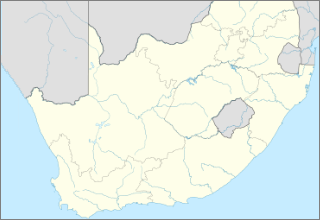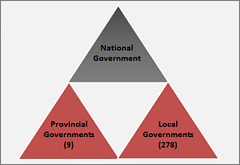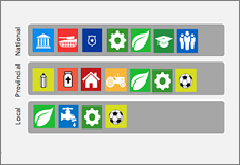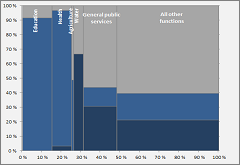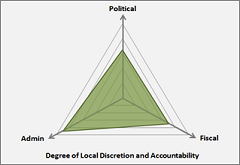 Country Profile Background
Country Profile Background
A decentralized system of governance was adopted in South Africa as part of the country’s initial post-apartheid transition (1990–94). After 1996, some of the devolution arrangements that were put in place, particularly at the provincial level, were abandoned by the ruling African National Congress to ensure greater central control over the development processes in rural and urban South Africa, and to manage political processes at the sub-national level. The result is an intergovernmental framework that emphasizes decentralized local control, but also relies on political, fiscal and administrative arrangements that are rather centralized.
 Organizational/Governance Structure of the Public Sector
Organizational/Governance Structure of the Public Sector
According to the Constitution (1996), South Africa’s public sector is composed of a national, provincial and local (municipal and district) sphere of government. As part of a co-operative (rather than hierarchical) approach to intergovernmental relations, these spheres are distinctive, interdependent and interrelated: governments within each sphere are expected to exercise their powers and perform their functions in a manner that does not encroach on the geographical, functional or institutional integrity of government in the other spheres. Metropolitan municipalities (8) provide local government services in major urban areas, whereas a two-tiered system if district municipalities (44) and local municipalities (226) provides local services in rural areas.
 Functional Responsibilities of the Local Public Sector
Functional Responsibilities of the Local Public Sector
The assignment of functions and responsibilities is carefully balanced between the different spheres of government and highly inter-related. Whereas the national government retains exclusive jurisdiction over ‘typical’ national functions (such as national defense), key social services (including basic education and health) are delivered at the provincial level. However, most provincial functional responsibilities are not exclusively provincial- instead they are concurrently assigned to the national and provincial spheres of government. The local sphere is mainly assigned local infrastructure and economic functions, such as local roads, water and sanitation, electricity, local public transport, parks and other local amenities. Traditional authorities carry residual, though changing administrative, developmental, and judicial authority at local levels in the rural areas.
 Fiscal Profile of the Public Sector
Fiscal Profile of the Public Sector
Over half (55.3%) of public sector expenditures in South Africa take place within the local public sector. Although municipal governments account for approximately 20% of total public expenditures, provinces are the largest sphere of government: slightly more than 30% of public expenditures are made at the provincial level. This reflects the important service delivery responsibilities assigned to the provincial sphere. In addition, 5.3% of public expenditures are made by the national government for localized public services (public order; higher education). The national government retains 44.7% of public sector resources for functions and activities that fall outside the local public sector.
The intergovernmental allocation of all unconditional and earmarked resources is established annually by the Division of Revenue Act. The main intergovernmental fiscal transfer mechanism in South Africa is the unconditional, formula-based Equitable Share grant. Provincial governments receive the overwhelming majority (93-98%) of their funding from their Equitable Share and conditional grants. In contrast, Equitable Share allocations only accounts for about 16% of municipal revenues (see graph). The overwhelming majority of municipal expenditures is funded from own source revenues, including property rates, service charges (including water and electricity fees), and other local revenues. This means that there is a significant problem of unfunded mandates at the local government level in South Africa.
 Institutional Profile of the Local Public Sector
Institutional Profile of the Local Public Sector
Provincial and municipal governments are subnational government bodies with their own elected political leadership and a considerable degree of discretion over their own administration and finances. As such, subnational political leaders are accountable to their own constituents as well as towards the national government. In practice, however, national government is able to exert considerable downward (political, personnel, and fiscal) control over provincial affairs (see graph). Provinces are largely responsible for delivering concurrent (national-provincial) functions and are almost fully dependent on transfers from the national government for their finances. Municipalities have a somewhat greater degree of political and fiscal autonomy.
Country Profile Information
Complete LPS Country Profile: South Africa (PDF)
Complete LPS Country Profile: South Africa (XLS)

